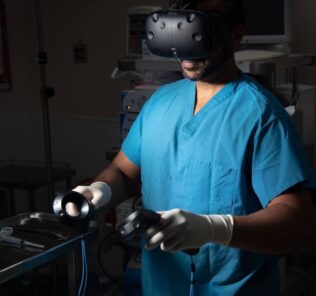Institute for Safe Medication Practices Worksheet Useful for Healthcare Simulation Programs
Healthcare Simulation provides an ideal methodology for educating healthcare practitioners of all levels to safely administer medications. Today’s article, guest authored by Dr. Kim Baily PhD, MSN, RN, CNE, previous Simulation Coordinator for Los Angeles Harbor College and Director of Nursing for El Camino College, highlights the National Patient Safety Goals for safe medication administration as well as recommendations from the Institute for Safe Medication Practice (ISMP) and provides multiple suggestions for changing basic healthcare simulation scenarios to reflect these standards (written in italics). Writing different simulation scenarios to cover the many facets of safe medication administration would be impossible however, one well written scenario based on national clinical standards can easily be tweaked to make a variety of scenarios to match different levels of clinical simulation learners or to change the scenario when multiple groups of learners will be using the same scenario setup.
National Patient Safety Goals
Identify Patients: Use at least two ways to identify patients. For example, the patient’s name and date of birth are checked against the Medication Administration either electronically or on paper. Simulation variations: Deliberately mismatch one of the identifiers.
Sponsored Content:
Labeling Medications: All medications should be labeled in the area where medicines and supplies are set up. This includes all syringes, cups and basins. An “immediately administered medication” is one that an authorized staff member prepares or obtains, takes directly to a patient, and administers to that patient without any break in the process. In perioperative and other procedural settings both on and off the sterile field, all medications and solutions that are not immediately administered should be labeled. This applies even if there is only one medication being used. The label should include the amount of medication or solution containing medication (if not apparent from the container), diluent name and volume (if not apparent from the container), strength, expiration date when not used within 24 hours and expiration time when expiration occurs in less than 24 hours. Note: The date and time are not necessary for short procedures, as defined by the hospital. Verify all medication or solution labels both verbally and visually.
Verification is done by two individuals qualified to participate in the procedure whenever the person preparing the medication or solution is not the person who will be administering it. Immediately discard any medication or solution found unlabeled. Remove all labeled containers on the sterile field and discard their contents at the conclusion of the procedure. Note: This does not apply to multi use vials that are handled according to infection control practices. All medications and solutions both on and off the sterile field and their labels are reviewed by entering and exiting staff responsible for the management of medications. Simulation variations: Have the medcart (or automatic medication dispenser) outside the simulation room. This will give learners practice in labelling medications. Have another nurse bring in a medication that is not labeled and hand it to the primary nurse to administer. Have the patient question the nurse if they bring any unlabeled medications. When sterile field skills are being practiced, have confederate comment on any medication not labeled that is likely to be administered by a healthcare practitioner who did not draw up the medication.
Medication Reconciliation: Record and pass along correct information about a patient’s medicines. Simulation variations: Have the patient mention a medication they take at home but they have not been receiving while in the hospital, question the dose they are receiving or note an allergy to a newly prescribed medication. Have the patient provide a list of medications that do not reconcile with the in-hospital medication list.
Anticoagulation Therapy: Use approved protocols and evidence-based practice guidelines for the initiation and maintenance of anticoagulant therapy that address medication selection; dosing, including adjustments for age and renal or liver function; drug–drug and drug–food interactions; and other risk factors as applicable. Coagulation therapy should follow a written policy addressing the need for baseline and ongoing laboratory tests to monitor and adjust anticoagulant therapy. The policy should include standards for identifying and responding to adverse drug events and for discharge teaching for patients who will go home on anticoagulants. Simulation variations: Anticoagulant protocols may challenge learners so allow review of protocols during prebriefing exercises. During the scenario, have lab results that require interventions such as changing doses or notifying healthcare providers. Have a new lab reveal liver or kidney abnormalities. Have learners complete discharge teaching related to anticoagulants as part of the scenario.
Sponsored Content:
Institute for Safe Medication Practices (ISMP)
The purpose of the ISMP Targeted Medication Safety Best Practices for Hospitals is to identify, inspire, and mobilize widespread, national adoption of consensus-based Best Practices for specific medication safety issues that continue to cause fatal and harmful errors in patients, despite repeated warnings in ISMP publications.
VinCRIStine (and other vinca alkaloids) inadvertently administered by the intrathecal route. This represents a “right route” error. Simulation variations: Although VinCRIStine not likely to be used very often in healthcare simulation scenarios, the identification of the “right route” applies to all medication administration. Write orders with the wrong route or supply pharmacy prepared medications with the wrong route designated on the label. Include patient teaching of discharge instructions.
Accidental daily dosing of oral methotrexate intended for weekly administration. Simulation variations: Include an MAR that clearly shows a weekly dose of methotrexate was given yesterday.
Missing or inaccurate patient weights, and mix-ups between metric and non-metric units when measuring and documenting weight. Simulation variations: “Right dose”. Provide pharmacy doses that are incorrectly calculated based on pounds instead of kilograms.
Unintended intravenous administration of oral medications. Simulation variations: Write orders with the wrong route or supply pharmacy prepared medications with the wrong route designated on the label or in the wrong type of syringe (oral versus for IV administration). Use of Enfit connections.
Mix-ups between milliliters and non-metric units when measuring oral liquid medications. Simulation variations: Include orders with incorrect dosing or provide incorrect syringes e.g. oral syringes with non-metric measurements or vice versa. Use ENFit connections. Have patients with oral devices connected to IV ports.
Inadvertent administration of neuromuscular blocking agents to patients, especially those not receiving proper ventilator assistance. Simulation variations: This could be included in a team simulation where the focus is team communication.
Errors when administering intravenous medication infusions. Administer medication infusions via a programmable infusion pump utilizing dose error-reduction systems. Simulation variations: provide pharmacy prepared solutions with wrong concentrations of medication, lack of patient information, or incorrect dosing time or deliver with wrong tubing.
Delay in administration or improper use of antidotes, reversal agents, and rescue agents. Simulation variations: Identify the need for antidote order when administering opioids. Create a healthcare simulation scenario in which a patient is overly sedated due to excessive opioids administration and where learners have to administer naloxone.
Accidental administration of an intravenous infusion of sterile water. Simulation variations: Include a variety of IV fluids for mixing medications including pure water, or use IV meds diluted with a large volume of water.
Errors during sterile compounding of medications. Simulation variations: More appropriate for pharmacy skills simulations.
Inappropriate use of extended-release and long-acting opioids and fentaNYL patches to treat acute pain and/or patients who are opioid-naïve. Simulation variations: Include fentaNYL patch for an opioid naïve patient or a patient with acute pain such as immediately post op in a patient with no previous medical history or surgery.
Transition to the bedside may be overwhelming for the learner if they have never been exposed to real world situations. Initially, simplified scenarios for the novice learner are necessary however, medication administration in the clinical setting tends to involve many facets. The complexity of a simulation will depend on the desired learning outcomes and the level of the learner. Including safe medication administration considerations in healthcare simulation scenarios can help the learner to think critically and transition to the challenge of clinical practice.
Worksheet for the ISMP Targeted Medication Safety Best Practices for Hospitals:
This tool was developed to assist hospitals in analyzing their current status with implementing the ISMP Targeted Medication Safety Best Practices for Hospitals (TMSBP). For each of the best practices, this worksheet allows hospitals to document their implementation status and detail their plan for full implementation. ISMP encourages hospitals to focus their medication safety efforts on these best practice recommendations, and this worksheet may help hospitals to identify gaps in their safety practices and to develop an action plan to address any vulnerabilities.
Visit the ISMP Website to Get the Worksheet!
Have a story to share with the global healthcare simulation community? Submit your simulation news and resources here!
Dr. Kim Baily, MSN, PhD, RN, CNE has had a passion for healthcare simulation since she pulled her first sim man out of the closet and into the light in 2002. She has been a full-time educator and director of nursing and was responsible for building and implementing two nursing simulation programs at El Camino College and Pasadena City College in Southern California. Dr. Baily is a member of both INACSL and SSH. She serves as a consultant for emerging clinical simulation programs and has previously chaired Southern California Simulation Collaborative, which supports healthcare professionals working in healthcare simulation in both hospitals and academic institutions throughout Southern California. Dr. Baily has taught a variety of nursing and medical simulation-related courses in a variety of forums, such as on-site simulation in healthcare debriefing workshops and online courses. Since retiring from full time teaching, she has written over 100 healthcare simulation educational articles for HealthySimulation.com while traveling around the country via her RV out of California.
Sponsored Content:


















